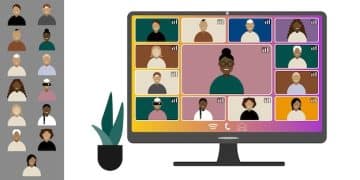Neurodiversity Communication: A US Business Guide for 2025

This guide provides US businesses with a comprehensive, practical framework for implementing inclusive communication strategies that effectively support neurodiverse employees and clients by 2025, fostering a more equitable and productive environment.
The landscape of the US workforce is evolving, recognizing the immense value that neurodiverse individuals bring. As businesses look towards 2025, a critical area of growth lies in mastering Inclusive Communication for Neurodiversity: A Practical Guide for US Businesses in 2025 to ensure all voices are heard and understood. This evolution is not just about compliance; it’s about unlocking untapped potential, fostering innovation, and building truly resilient teams.
Understanding Neurodiversity and Its Impact on Communication
Effective communication is the bedrock of any successful organization. However, traditional communication methods often inadvertently exclude or disadvantage neurodivergent individuals, leading to misunderstandings, reduced productivity, and feelings of isolation. Recognizing the diverse ways neurodivergent brains process information is the first step toward building truly inclusive environments.
The Spectrum of Neurodiversity
Neurodiversity encompasses a broad range of neurological differences, including but not limited to autism, ADHD, dyslexia, dyspraxia, and Tourette’s syndrome. Each condition presents unique cognitive strengths and challenges, which can significantly influence how individuals send and receive information. For instance, an autistic person might prefer direct, literal language and struggle with subtle social cues, while someone with ADHD might find it hard to maintain focus during long, complex discussions. Understanding these nuances is crucial for tailoring communication strategies. Businesses must move beyond a one-size-fits-all approach and embrace flexibility. This means acknowledging that what works for one team member may not work for another, and being open to adapting methods to suit individual needs.
The impact of neurodiversity on communication extends to various aspects of professional life, from daily interactions to formal presentations. Misinterpretations can arise from differences in processing speed, sensory sensitivities, and literal versus figurative understanding of language. A common challenge faced by neurodivergent individuals is the pressure to conform to neurotypical communication norms, which can be exhausting and lead to burnout. Businesses that address these challenges proactively will not only support their neurodivergent employees but also enhance overall team cohesion and performance.
- Autism: Often involves literal interpretation, challenges with non-verbal cues, and preference for direct communication.
- ADHD: Can manifest as difficulty with sustained attention, impulsivity, or hyperfocus, impacting listening and information retention.
- Dyslexia: Primarily affects reading, writing, and spelling, requiring consideration for written communication formats.
- Dyspraxia: May impact motor skills, coordination, and organization, potentially affecting written and spoken expression.
For US businesses, preparing for 2025 means integrating neurodiversity understanding into their core values. This includes leadership training, employee workshops, and the development of clear, accessible communication guidelines. It’s about creating a culture where diverse communication styles are not just tolerated but celebrated as assets that enrich the workplace.
A deep dive into neurodiversity reveals that these differences are not deficits but rather variations in human operating systems. By shifting perspective from “disability” to “diversity,” businesses can unlock innovative problem-solving and unique perspectives. This paradigm shift encourages empathy and paves the way for truly inclusive practices that benefit everyone. It’s a journey of continuous learning and adaptation, moving beyond basic awareness to genuine understanding and practical implementation.
This initial understanding lays the groundwork for developing practical strategies. It highlights the need for intentionality in all communication acts, from choosing the right medium to framing messages appropriately. It is about building bridges of understanding that transcend neurological differences, fostering an environment where every individual can contribute their best.
Key Principles for Neuro-Inclusive Communication in the Workplace
Establishing foundational principles is essential for developing effective neuro-inclusive communication strategies. These principles serve as a compass, guiding actions and decisions towards creating an environment where every individual, regardless of their neurological profile, can thrive. They emphasize clarity, flexibility, and empathy, forming the backbone of an truly inclusive workplace.
At the heart of neuro-inclusive communication are three core tenets: clarity, consistency, and flexibility. Clarity ensures that messages are unambiguous and easily understood, minimizing potential misinterpretations. Consistency in communication channels and expectations helps establish predictability, which can be particularly beneficial for neurodivergent individuals. Flexibility acknowledges that one size does not fit all, encouraging adaptation to diverse communication preferences and needs. Adhering to these principles transforms communication from a potential barrier into a powerful tool for inclusion.
Fostering Clarity and Directness
Ambiguity can be a significant hurdle for neurodivergent individuals who often thrive with direct and explicit instructions. Complex jargon, vague expectations, and hidden meanings can lead to anxiety and hinder performance. Businesses should prioritize clear, concise language, avoiding idioms, sarcasm, and figurative speech that might be misinterpreted. When assigning tasks or providing feedback, be as specific as possible, outlining expectations, deadlines, and desired outcomes unequivocally. This precision reduces cognitive load and allows neurodivergent employees to focus their energy on the task at hand rather than deciphering hidden meanings. Implementing a culture of direct communication benefits all employees by streamlining processes and reducing errors.
For meetings, setting clear agendas in advance with defined objectives helps everyone prepare and participate effectively. During discussions, summarizing key points and action items verbally and in writing ensures that information is retained and understood by all. Encouraging questions and providing dedicated time for clarification further reinforces clarity, creating a safe space for asking for more detail without fear of judgment. This directness extends beyond verbal communication to written materials, where simplicity and clear structure are paramount.
Embracing Flexibility and Multiple Modalities
No single communication method works for everyone. Neuro-inclusive communication means offering a range of options and allowing individuals to choose what best suits their processing style. Some neurodivergent individuals may prefer written communication (emails, instant messages) over verbal, as it provides time for processing and reference. Others might benefit from visual aids, diagrams, or mind maps to grasp complex information. Offering choices demonstrates respect for individual needs and empowers employees to communicate in ways that are most effective for them. This flexibility also applies to meeting structures, allowing for breaks, alternative participation methods (e.g., chat functions), and varied formats.
- Written Communication: Utilizing email, direct messaging, and shared documents for detailed instructions and follow-ups.
- Visual Aids: Employing diagrams, flowcharts, infographics, and presentations with clear visuals to support complex information.
- Verbal Communication: Providing options for structured discussions, one-on-one meetings, and recorded sessions for later review.
- Sensory Considerations: Being mindful of environmental factors (lighting, noise) that can impact concentration and comfort.
This principle also extends to responding to communication. Recognizing that some individuals may need more time to formulate a response, both in verbal conversations and written exchanges, is crucial. Patience and understanding are key components of a flexible communication strategy. Businesses adopting this approach will see improved engagement and reduced stress levels among their neurodivergent workforce. It’s about creating communication ecosystems that are adaptable and responsive to the rich tapestry of human cognition.

Practical Strategies for Written Communication
Written communication forms a significant part of business operations, from emails and reports to policy documents and project briefs. For neuro-inclusive practices, it’s crucial to optimize these materials to be accessible and easily digestible for everyone, particularly neurodivergent individuals who may process information differently. The goal is to reduce cognitive load and enhance comprehension.
Simplifying Language and Structure
Complex, jargon-filled language can be a major barrier. Businesses should adopt plain language principles across all written communications. This means using simple vocabulary, avoiding acronyms without explanation, and breaking down complex ideas into smaller, more manageable chunks. Sentences should be concise, and paragraphs should be short and focused on a single idea. Employing active voice typically makes sentences clearer and more direct.
Structuring documents logically is equally important. Use clear headings and subheadings to guide the reader through the content. Bullet points and numbered lists are invaluable for presenting information concisely and highlighting key takeaways. White space around text can improve readability and reduce visual clutter, which helps individuals with visual processing differences or sensory sensitivities. Prioritize conveying the most important information early in a document, ensuring that even if a reader only skims, they grasp the core message.
Here are some specific tips:
- Use clear, concise sentences, avoiding overly complex grammar.
- Break down long paragraphs into shorter ones, focusing on one idea per paragraph.
- Utilize headings and subheadings to create a scannable structure.
- Incorporate bullet points and numbered lists for easy digestion of information.
- Explain all acronyms and technical terms upon their first use.
Regularly reviewing written materials for clarity and accessibility should become standard practice. This might involve peer review by a diverse group of employees or using readability tools to assess the complexity of the language. The aim is to make information universally understandable, reducing the need for constant clarification and ultimately saving time and resources.
Leveraging Visuals and Formatting
Visuals can significantly enhance comprehension for many neurodivergent individuals. Diagrams, flowcharts, infographics, and images can break down complex processes or data into an easily understandable format. When incorporating visuals, ensure they are high-quality, relevant, and accompanied by clear, concise captions or descriptions. Avoid overly busy or distracting graphics.
Formatting plays a critical role in readability. Opt for sans-serif fonts (like Arial, Verdana, or Calibri) that are generally easier to read for individuals with dyslexia. Maintain a consistent font size (e.g., 12-14pt for body text) and use sufficient line spacing to prevent text from appearing crowded. Bold text should be used sparingly for emphasis, not for entire sentences or paragraphs. Use color contrast carefully to highlight information, ensuring it’s accessible to individuals with color blindness. Providing options for text size and contrast, where possible (e.g., in digital documents), further enhances inclusivity.
Consider providing alternative formats for documents where appropriate. For example, a detailed written report might be supplemented with a brief executive summary using bullet points or a short video explaining key findings. This multi-modal approach caters to different learning and processing styles. Implementing these strategies for written communication demonstrates a commitment to inclusive practices and ensures that vital information reaches all employees effectively. It is about making information accessible in the truest sense of the word, eliminating unintentional barriers that might prevent neurodivergent individuals from fully engaging with workplace content.
Enhancing Verbal and Meeting Communication
Verbal communication, particularly in meeting settings, presents unique challenges and opportunities for neuro-inclusion. The dynamic nature of spoken interaction, combined with varying processing speeds and social cues, necessitates thoughtful adjustments to ensure all participants can contribute and comprehend effectively. The goal is to create environments where spoken words empower, rather than exclude.
Structuring Meetings for Inclusivity
Well-structured meetings are fundamental for neuro-inclusive verbal communication. Before any meeting, distribute a clear agenda with defined objectives and expected outcomes. This allows neurodivergent individuals to prepare, process information in advance, and formulate their contributions. During the meeting, designate a facilitator who can ensure orderly discussion, manage speaking turns, and intervene if conversations become tangential or exclusive.
Encourage participants to speak one at a time and avoid interrupting. Allowing brief pauses after someone finishes speaking can give neurodivergent individuals processing time before they respond or ask a question. For virtual meetings, encourage the use of chat functions for questions or comments, offering an alternative to verbal interjection. Summarize key decisions and action items periodically during the meeting and distribute a concise summary afterward. This reinforces understanding and provides a tangible record.
- Pre-Meeting Preparation: Distribute agendas and pre-reads well in advance.
- Clear Facilitation: Assign a facilitator to manage discussion flow and ensure everyone has a chance to speak.
- Pacing and Pauses: Allow for pauses, give individuals time to process and formulate responses.
- Alternative Participation Methods: Utilize chat functions, virtual hand raises, or written note-taking during discussions.
- Post-Meeting Follow-up: Circulate clear summaries of decisions and action items.
Creating a culture where it’s acceptable for employees to request clarification or repetition without embarrassment is vital. Leaders should model this behavior, demonstrating openness and a willingness to adapt communication styles for the benefit of the team. This proactive structuring minimizes anxiety and maximizes participation from all attendees.
Tips for Clear Spoken Communication
When speaking, strive for clarity, conciseness, and directness. Avoid using rhetorical questions, sarcasm, or analogies that might be difficult to interpret literally. Speak at a moderate pace, allowing time for others to process your words. If you’re discussing a complex topic, break it down into smaller, digestible pieces, and offer to re-explain or provide additional context.
Be mindful of non-verbal cues. While some neurodivergent individuals might struggle to interpret these, clear and consistent body language (e.g., open posture, direct eye contact) can sometimes aid understanding for others. However, avoid relying solely on non-verbal communication to convey important messages. Always pair non-verbal cues with explicit verbal explanations. When asking questions, make them open-ended to encourage detailed responses, but be prepared to follow up with specific prompts if needed. Confirm understanding by asking “Does that make sense?” or “Can you summarize what you heard?” rather than assuming comprehension.
Consider the environment in which verbal communication takes place. Excessive background noise, poor acoustics, or visual distractions can significantly impair processing for some neurodivergent individuals. Where possible, choose quiet spaces for important conversations and ensure good audio quality for virtual interactions. These deliberate adjustments create a more welcoming and effective verbal communication experience for everyone.
Leveraging Technology for Inclusive Communication
In the modern workplace, technology serves as a powerful enabler for inclusive communication, bridging gaps and providing flexible solutions that cater to diverse needs. When strategically implemented, digital tools can significantly enhance accessibility and understanding for neurodivergent employees, offering alternatives to traditional methods.
Utilizing Digital Tools and Platforms
Many digital platforms offer features that can be customized to support various communication preferences. For example, collaboration tools with chat functions, shared documents, and project management features allow for asynchronous communication, which can be beneficial for individuals who need more time to process information or prefer written over verbal exchanges. These platforms often include notifications and reminders, helping individuals with organizational challenges or executive function differences stay on track.
Video conferencing platforms offer features like closed captions, transcription services, and screen sharing, which are invaluable for those who benefit from visual or written reinforcement of spoken content. Providing these options can turn a potentially overwhelming verbal meeting into an accessible interaction. Furthermore, internal wikis or knowledge bases serve as centralized repositories for information, allowing employees to access data at their own pace and revisit it as needed, reducing reliance on rote memory.
- Asynchronous Communication Platforms: Teams, Slack, Asana, Trello for written updates and project tracking.
- Video Conferencing Features: Closed captions, live transcription, virtual backgrounds to reduce distractions.
- Knowledge Management Systems: Internal wikis, shared drives, and FAQs for self-service information retrieval.
- Communication Aids: Text-to-speech, speech-to-text software, and predictive text tools.
The key is not just to have these tools but to actively train employees on their effective use for inclusive communication. Encourage their adoption and integrate them into routine workflows. This fosters a culture where accessibility is not an afterthought but an integral part of daily operations.
Accessible Document and Presentation Design
The principles of inclusive design extend to all digital documents and presentations. When creating these materials, consider accessibility from the outset. This includes using accessible fonts, appropriate color contrast, and clear, logical navigation. Tools like Microsoft Office and Google Workspace offer built-in accessibility checkers that can identify potential issues, such as missing alt text for images or poorly structured headings.
For presentations, avoid overly busy slides with excessive text or animations that might be distracting. Instead, focus on clear, concise visuals that complement your spoken message. Provide attendees with copies of slides or transcriptions beforehand, allowing them to follow along and take notes. When sharing videos, ensure they have accurate captions or transcripts.
Screen readers and other assistive technologies rely on well-structured digital content. This means using proper heading tags (H1, H2, H3), descriptive link text, and alternative text for images. Training content creators on these best practices ensures that all digital assets produced by the business are inherently accessible. By leveraging technology thoughtfully, US businesses can create a significantly more inclusive communication ecosystem by 2025, enabling neurodivergent individuals to fully participate and contribute their unique strengths. This proactive approach to digital accessibility benefits everyone, streamlining information flow and improving overall clarity.
Training and Culture Building: The Human Element
While strategies and technology are vital, the true success of neuro-inclusive communication hinges on an organization’s culture and the consistent training of its people. Communication is inherently a human act, and fostering empathy, understanding, and adaptability among all employees is paramount. This human element ensures that inclusive practices are embraced organically, not merely as corporate mandates.
Developing Neurodiversity Awareness Training
Comprehensive training programs are essential to educating employees and leaders about neurodiversity. These programs should go beyond basic definitions, delving into the lived experiences of neurodivergent individuals, common communication challenges they might face, and the immense value they bring to the workplace. Training should be interactive, incorporating diverse perspectives, and ideally led by neurodivergent individuals or experts in the field.
Key topics for training include:
- Understanding Different Neurotypes: Providing insights into conditions like autism, ADHD, dyslexia, and dyspraxia.
- Recognizing Communication Differences: Highlighting varied processing speeds, sensory sensitivities, and literal interpretations.
- Best Practices for Inclusive Language: Guiding participants on using respectful and precise terminology.
- Active Listening and Empathy: Developing skills to truly understand diverse perspectives.
- Conflict Resolution: Addressing potential communication breakdowns with sensitivity and constructive feedback.
Training should be ongoing, not a one-time event, evolving with new research and best practices. It should be mandatory for all staff, particularly those in leadership, HR, and client-facing roles. The goal is to build genuine understanding and reduce unconscious bias, leading to more thoughtful and effective interactions throughout the organization. This foundational knowledge empowers employees to adapt their communication styles proactively.
Fostering an Inclusive Culture
An inclusive culture is one where neurodiversity is celebrated as a strength, and diverse communication styles are met with understanding rather than judgment. This culture starts at the top, with leadership actively championing neuro-inclusion and demonstrating a commitment to creating an accessible environment. Leaders should openly discuss the importance of neurodiversity, share success stories, and actively seek feedback on how communication can be improved.
Encourage open dialogue about communication preferences. Create safe spaces where employees feel comfortable sharing their needs without fear of stigmatization. This might involve setting up employee resource groups for neurodivergent individuals and allies, or establishing mentorship programs. Implementing a “ask don’t assume” policy for individual communication needs can be highly effective.
Regularly solicit feedback on communication strategies and be prepared to adapt. What works for one person might not work for another, and continuous improvement is key. Celebrate successes in inclusive communication and highlight how it contributes to team cohesion and business outcomes. Ultimately, building a neuro-inclusive culture is about creating a workplace where every voice feels heard, valued, and empowered to contribute their unique talents. It’s a continuous journey of learning and adaptation, deeply rooted in empathy and mutual respect.
Measuring Success and Continuous Improvement
Implementing neuro-inclusive communication is not a one-time project but an ongoing commitment. To ensure genuine impact and relevance in 2025 and beyond, US businesses must establish robust mechanisms for measuring the effectiveness of their strategies and fostering a culture of continuous improvement. This iterative approach allows for adaptation, refinement, and sustained positive change.
Establishing Metrics for Communication Effectiveness
Quantifying the impact of inclusive communication can be challenging, but certain metrics can provide valuable insights. Beyond traditional employee engagement surveys, consider specific questions targeting communication clarity, accessibility of information, and perceived psychological safety in expressing diverse communication needs. Anonymous feedback mechanisms and suggestion boxes can capture qualitative data.
Consider metrics such as:
- Employee Retention Rates: Are neurodivergent employees staying longer?
- Productivity and Performance: Is communication clarity translating into improved work output?
- Feedback on Communication Channels: Surveys on the effectiveness of different modalities (written, verbal, visual).
- Reduction in Misunderstandings: Tracking instances of communication breakdowns or conflicts related to communication.
- Participation in Inclusive Initiatives: Employee engagement in neurodiversity resource groups or training.
Regularly collecting and analyzing these data points will help identify areas of strength and weakness. It’s crucial to disaggregate data where possible (while maintaining anonymity) to understand the experiences of neurodivergent employees specifically. This data-driven approach informs future adjustments and validates the investment in inclusive communication. It transforms anecdotal observations into concrete evidence, strengthening the case for continued focus on neuro-inclusive practices.
Iterative Feedback and Adaptation
The journey towards neuro-inclusive communication is dynamic, requiring constant learning and adaptation. Establish formal and informal channels for ongoing feedback. This could include regular pulse surveys, dedicated focus groups with neurodivergent employees and their allies, or anonymous communication audits. Encourage a culture where employees feel empowered to provide constructive criticism on communication processes without fear of reprisal.
Based on collected data and feedback, be prepared to iterate and refine communication guidelines and training programs. What works well initially might need adjustments as the organization grows or as new technologies emerge. Share successes and lessons learned transparently across the organization. This transparency builds trust and demonstrates a genuine commitment to inclusion.
For example, if feedback indicates that video meetings are still challenging for some, explore options for pre-recorded content or text-based summaries as alternatives. If written instructions are frequently misunderstood, review clarity guidelines and offer workshops on effective writing. The goal is to create a responsive system that continuously evolves to meet the diverse communication needs of all employees.
By prioritizing measurement and continuous improvement, US businesses can ensure their neuro-inclusive communication strategies remain effective, relevant, and supportive for all employees throughout 2025 and into the future. This commitment to ongoing refinement solidifies their position as truly inclusive employers, benefiting from the full spectrum of talents within their neurodiverse workforce. It underscores the importance of a living, breathing strategy rather than a static decree.
Beyond the Workplace: External Communication
Inclusive communication for neurodiversity extends beyond internal operations to encompass how businesses interact with their external stakeholders: clients, customers, and the broader public. In 2025, a truly inclusive US business will ensure its outward-facing communication strategies are equally accessible and welcoming, reflecting a deep commitment to diversity and inclusion.
Accessible Marketing and Customer Service
Marketing materials, websites, and social media content are often the first points of contact for potential customers and clients. Businesses should ensure these platforms are designed with accessibility in mind. Websites should comply with Web Content Accessibility Guidelines (WCAG), including features like alternative text for images, clear navigation, and keyboard compatibility. This not only benefits neurodivergent individuals but also people with other disabilities and even those with temporary impairments.
When crafting marketing messages, prioritize clarity and avoid overly complex language or abstract concepts that might confuse or exclude. Consider offering information in multiple formats – text, video with captions, audio – to cater to diverse processing preferences. For customer service, training staff to recognize and respond empathetically to diverse communication styles is paramount. Provide options for communication channels, such as email, chat, or phone, allowing customers to choose their preferred method. Staff should be patient, avoid jargon, and be prepared to reiterate information clearly. Offering a quiet, less stimulating environment for in-person customer interactions, if applicable, can also be a valuable consideration.
- Website Accessibility: Adhering to WCAG standards (alt text, clear navigation, keyboard compatibility).
- Multi-Format Content: Providing information in text, video (with captions), and audio formats.
- Clear Marketing Language: Avoiding jargon, idioms, and complex metaphors.
- Customer Service Training: Empathy, patience, and clear communication techniques for all staff.
- Diverse Communication Channels: Offering email, chat, phone, and even written correspondence options.
By making external communications accessible, businesses not only fulfill their ethical responsibilities but also expand their market reach, appealing to a broader customer base and enhancing their reputation as an inclusive brand. It’s a clear signal of respect and understanding.
Public Image and Brand Perception
A business’s commitment to neuro-inclusive communication influences its public image and brand perception. Companies that actively champion diversity and inclusion, including neurodiversity, are increasingly viewed favorably by consumers, investors, and potential employees. This positive perception can translate into competitive advantages, attracting top talent and fostering loyalty.
Public statements, press releases, and corporate social responsibility reports should reflect an understanding and promotion of neurodiversity. Partnering with neurodiversity advocacy groups or participating in awareness campaigns can further strengthen a business’s commitment. Transparency about internal inclusion efforts can also resonate positively.
However, it’s crucial that these external communications are authentic and backed by genuine internal practices. “Neurodiversity washing” – claiming to be inclusive without substantive internal changes – can backfire and damage reputation. By consistently implementing inclusive communication internally and externally, US businesses can solidify their position as leaders in fostering genuinely diverse and equitable environments, benefiting not only neurodivergent individuals but society as a whole. This holistic approach signals a deep-seated commitment that goes beyond mere rhetoric to tangible action.

| Key Point | Brief Description |
|---|---|
| 💡 Clarity & Flexibility | Prioritize direct, unambiguous language and offer multiple communication formats. |
| ✍️ Written Accessibility | Simplify language, use clear structure, and leverage visuals for better comprehension. |
| 🗣️ Meeting Inclusivity | Structure discussions, allow processing time, and use clear spoken communication. |
| ⚙️ Tech & Culture | Utilize accessibility features in digital tools and foster empathy through training. |
Frequently Asked Questions About Neuro-Inclusive Communication
▼
Neuro-inclusive communication involves adapting how we exchange information to accommodate diverse neurological processing styles, particularly those of neurodivergent individuals. It means using clear, direct language, offering multiple communication modalities, and creating environments where everyone feels comfortable expressing and receiving information effectively. The goal is to minimize misunderstandings stemming from differing cognitive approaches.
▼
In 2025, inclusive communication is vital for US businesses to leverage the full potential of a diverse workforce, including neurodivergent talent. It enhances productivity, fosters innovation, improves employee retention, and strengthens a company’s reputation as an equitable employer. Moreover, it expands market reach by appealing to a broader customer base, demonstrating a commitment to true diversity.
▼
Businesses can simplify written communication by adopting plain language, using concise sentences, and breaking down complex ideas into manageable chunks. Employ clear headings, bullet points, and numbered lists to improve readability. Additionally, leveraging visual aids like diagrams and charts, and ensuring accessible formatting (e.g., sans-serif fonts, good color contrast) significantly enhances comprehension for neurodivergent readers.
▼
Technology is a powerful tool for neuro-inclusive communication. Digital platforms offer asynchronous communication options, reducing pressure for immediate responses. Video conferencing tools provide closed captions and transcriptions. Assistive technologies support text-to-speech or speech-to-text. By using these tools and designing digital content with accessibility features like alternative text and proper heading structures, businesses can cater to diverse communication needs.
▼
Fostering a neuro-inclusive culture starts with comprehensive awareness training for all employees and leadership. It involves promoting empathy, understanding diverse communication styles, and creating safe spaces for open dialogue. Encouraging feedback, adapting strategies, and celebrating success in inclusive practices also contribute significantly. Leadership must champion these efforts, visibly demonstrating commitment to a genuinely diverse and welcoming environment for everyone.
Conclusion
As US businesses look toward 2025, the proactive adoption of neuro-inclusive communication is not merely a beneficial practice but a strategic imperative. By implementing clear, flexible, and empathetic communication strategies across all facets of their operations, from internal interactions to external engagements, organizations can unlock the immense potential of their neurodivergent workforce and customer base. This commitment to genuine inclusivity fosters innovation, enhances productivity, and builds a stronger, more resilient business culture, proving that understanding and adapting to diverse minds is crucial for future success.





